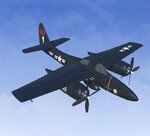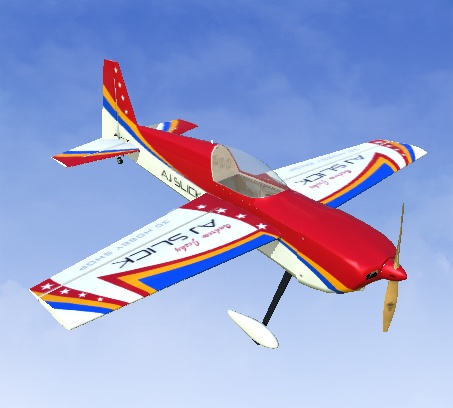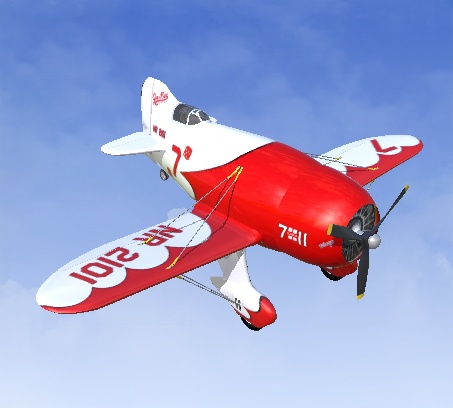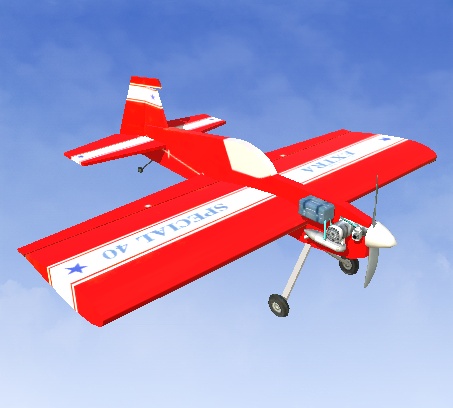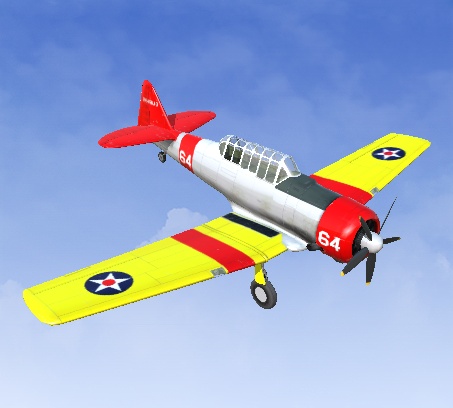Grumman F7F Tigercat
From Wikipedia, the free encyclopedia
Jump to navigation Jump to search
"Tigercat" redirects here. For other uses, see Tigercat (disambiguation).
�
The Grumman F7F Tigercat is a heavy fighter aircraft that served with the United States Navy (USN) and United States Marine Corps (USMC) from late in World War II until 1954. It was the first twin-engine fighter to be deployed by the USN. While the Tigercat was delivered too late to see combat in World War II, it saw action as a night fighter and attack aircraft during the Korean War.
Designed initially for service on Midway-class aircraft carriers, early production F7Fs were land-based variants. The type was too large to operate from older and smaller carriers, and only a late variant (F7F-4N) was certified for carrier service.
Contents
Based on the earlier Grumman XP-50 that was eventually canceled, the company developed the XP-65 (Model 51) further for a future "convoy fighter" concept. In 1943, work on the XP-65 was terminated in favor of the design that would eventually become the F7F.[1] The contract for the prototype XF7F-1 was signed on 30 June 1941. Grumman's aim was to produce a fighter that outperformed and outgunned all existing fighter aircraft, and that had an auxiliary ground attack capability.[2]
An F7F-3N of VMF(N)-513 at Wonsan, Korea, in 1952.
Performance of the prototype and initial production aircraft met expectations; the F7F was one of the fastest piston-engine fighters, with a top speed significantly greater than single-engine USN aircraft — 71 mph faster than a Grumman F6F Hellcat at sea level.[3] Captain Fred Trapnell, one of the premier USN test pilots of the era, stated: "It's the best damn fighter I've ever flown."[4] The F7F was to be heavily-armed — four 20 mm cannon and four 50 caliber (0.50 in; 12.7 mm) machine guns, as well as underwing and under-fuselage hardpoints for bombs and torpedoes. This speed and firepower was bought at the cost of heavy weight and a high landing speed, but what caused the aircraft to fail carrier suitability trials was poor directional stability with only one engine operational, as well as problems with the tailhook design.[5] The initial production series was, therefore, used only from land bases by the USMC, as night fighters with APS-6 radar.[6]
While the F7F was initially also known as the Grumman Tomcat, this name was abandoned, because it was considered at the time to have excessively sexual overtones;[7] (from the 1970s, the name Tomcat became commonly associated with, and officially used by the Navy for, another Grumman design, the F-14 twin-jet carrier-based interceptor). The first production variant was the single-seat F7F-1N aircraft; after the 34th production aircraft, a second seat for a radar operator was added and these aircraft were designated F7F-2N.
A second production version, the F7F-3, was modified to correct the issues that caused the aircraft to fail carrier acceptance, and this version was again trialled on the USS Shangri-La. A wing failure on a heavy landing caused the failure of this carrier qualification as well. F7F-3 aircraft were produced in day fighter, night fighter, and photo-reconnaissance versions.[8]
The final production version, the F7F-4N, was extensively rebuilt for additional strength and stability, and did pass carrier qualification, but only 12 were built.[8]
Operational history
Marine Corps night fighter squadron VMF(N)-513 flying F7F-3N Tigercats saw action in the early stages of the Korean War, flying night interdiction and fighter missions and shooting down two Polikarpov Po-2 biplanes.[9] This was the only combat use of the aircraft.
Most F7F-2Ns were modified to control drones for combat training, and these gained bubble canopies over the rear cockpit for the drone controller. An F7F-2D used for pilot transitioning also had a rear sliding, bubble canopy.[10]
In 1945, two Tigercats, serial numbers TT346 and TT349, were evaluated, but rejected by the British Royal Navy, who preferred a naval version of the de Havilland Hornet.[11]
Variants
The second XF7F-1 in 1946.
An F7F-2D drone controller with an additional F8F windshield.
An F7F-3N night fighter of VMF(N)-513 in April 1950.
XP-65 Proposed United States Army Air Forces pursuit fighter. XF7F-1 Prototype aircraft, two built. F7F-1 Tigercat Twin-engine fighter-bomber aircraft, powered by two Pratt & Whitney R-2800-22W radial piston engines. First production version, 34 built. F7F-1N Tigercat Single-seat night fighter aircraft, fitted with an APS-6 radar. XF7F-2N Night-fighter prototype, one built. F7F-2N Tigercat Two-seat night fighter, 65 built. F7F-2D Small numbers of F7F-2Ns converted into drone control aircraft. The aircraft were fitted with a Grumman F8F Bearcat windshield behind the cockpit. F7F-3 Tigercat Single-seat fighter-bomber aircraft, powered by two Pratt & Whitney R-2800-34W radial piston engines and featuring an enlarged tailfin for improved stability at high altitudes, 189 built. F7F-3N Tigercat Two-seat night fighter aircraft, 60 built. F7F-3E Tigercat Small numbers of F7F-3s were converted into electronic warfare aircraft. F7F-3P Tigercat Small numbers of F7F-3s were converted into photo-reconnaissance aircraft. F7F-4N Tigercat Two-seat night-fighter aircraft, fitted with a tailhook and other naval equipment, 12 built.
This It's got a Chuck aaron registration N8O Redbull Flight OPS-901 Name is "Grumman CFA-7J Glacier cat".
For Realflight RF7 RF7.5 RF8 And RF9.5 Simulator RC.
Enjoy.
 ✈
✈
From Wikipedia, the free encyclopedia
Jump to navigation Jump to search
"Tigercat" redirects here. For other uses, see Tigercat (disambiguation).
�
| F7F Tigercat | |
|---|---|
| An F7F-3P preserved in United States Marine Corps markings in flight | |
| Role | Heavy fighter |
| National origin | United States |
| Manufacturer | Grumman |
| First flight | 2 November 1943 |
| Introduction | 1944 |
| Retired | 1954 |
| Primary users | United States Navy United States Marine Corps |
| Produced | 1943–1946 |
| Number built | 364 |
| Developed into | Grumman XTSF |
Designed initially for service on Midway-class aircraft carriers, early production F7Fs were land-based variants. The type was too large to operate from older and smaller carriers, and only a late variant (F7F-4N) was certified for carrier service.
Contents
- 1 Design & development
- 2 Operational history
- 3 Variants
- 4 Operators
- 5 Surviving aircraft
- 6 Specifications (F7F-4N Tigercat)
- 7 See also
- 8 References
- 9 External links
Based on the earlier Grumman XP-50 that was eventually canceled, the company developed the XP-65 (Model 51) further for a future "convoy fighter" concept. In 1943, work on the XP-65 was terminated in favor of the design that would eventually become the F7F.[1] The contract for the prototype XF7F-1 was signed on 30 June 1941. Grumman's aim was to produce a fighter that outperformed and outgunned all existing fighter aircraft, and that had an auxiliary ground attack capability.[2]
An F7F-3N of VMF(N)-513 at Wonsan, Korea, in 1952.
Performance of the prototype and initial production aircraft met expectations; the F7F was one of the fastest piston-engine fighters, with a top speed significantly greater than single-engine USN aircraft — 71 mph faster than a Grumman F6F Hellcat at sea level.[3] Captain Fred Trapnell, one of the premier USN test pilots of the era, stated: "It's the best damn fighter I've ever flown."[4] The F7F was to be heavily-armed — four 20 mm cannon and four 50 caliber (0.50 in; 12.7 mm) machine guns, as well as underwing and under-fuselage hardpoints for bombs and torpedoes. This speed and firepower was bought at the cost of heavy weight and a high landing speed, but what caused the aircraft to fail carrier suitability trials was poor directional stability with only one engine operational, as well as problems with the tailhook design.[5] The initial production series was, therefore, used only from land bases by the USMC, as night fighters with APS-6 radar.[6]
While the F7F was initially also known as the Grumman Tomcat, this name was abandoned, because it was considered at the time to have excessively sexual overtones;[7] (from the 1970s, the name Tomcat became commonly associated with, and officially used by the Navy for, another Grumman design, the F-14 twin-jet carrier-based interceptor). The first production variant was the single-seat F7F-1N aircraft; after the 34th production aircraft, a second seat for a radar operator was added and these aircraft were designated F7F-2N.
A second production version, the F7F-3, was modified to correct the issues that caused the aircraft to fail carrier acceptance, and this version was again trialled on the USS Shangri-La. A wing failure on a heavy landing caused the failure of this carrier qualification as well. F7F-3 aircraft were produced in day fighter, night fighter, and photo-reconnaissance versions.[8]
The final production version, the F7F-4N, was extensively rebuilt for additional strength and stability, and did pass carrier qualification, but only 12 were built.[8]
Operational history
Marine Corps night fighter squadron VMF(N)-513 flying F7F-3N Tigercats saw action in the early stages of the Korean War, flying night interdiction and fighter missions and shooting down two Polikarpov Po-2 biplanes.[9] This was the only combat use of the aircraft.
Most F7F-2Ns were modified to control drones for combat training, and these gained bubble canopies over the rear cockpit for the drone controller. An F7F-2D used for pilot transitioning also had a rear sliding, bubble canopy.[10]
In 1945, two Tigercats, serial numbers TT346 and TT349, were evaluated, but rejected by the British Royal Navy, who preferred a naval version of the de Havilland Hornet.[11]
Variants
The second XF7F-1 in 1946.
An F7F-2D drone controller with an additional F8F windshield.
An F7F-3N night fighter of VMF(N)-513 in April 1950.
XP-65 Proposed United States Army Air Forces pursuit fighter. XF7F-1 Prototype aircraft, two built. F7F-1 Tigercat Twin-engine fighter-bomber aircraft, powered by two Pratt & Whitney R-2800-22W radial piston engines. First production version, 34 built. F7F-1N Tigercat Single-seat night fighter aircraft, fitted with an APS-6 radar. XF7F-2N Night-fighter prototype, one built. F7F-2N Tigercat Two-seat night fighter, 65 built. F7F-2D Small numbers of F7F-2Ns converted into drone control aircraft. The aircraft were fitted with a Grumman F8F Bearcat windshield behind the cockpit. F7F-3 Tigercat Single-seat fighter-bomber aircraft, powered by two Pratt & Whitney R-2800-34W radial piston engines and featuring an enlarged tailfin for improved stability at high altitudes, 189 built. F7F-3N Tigercat Two-seat night fighter aircraft, 60 built. F7F-3E Tigercat Small numbers of F7F-3s were converted into electronic warfare aircraft. F7F-3P Tigercat Small numbers of F7F-3s were converted into photo-reconnaissance aircraft. F7F-4N Tigercat Two-seat night-fighter aircraft, fitted with a tailhook and other naval equipment, 12 built.
This It's got a Chuck aaron registration N8O Redbull Flight OPS-901 Name is "Grumman CFA-7J Glacier cat".
For Realflight RF7 RF7.5 RF8 And RF9.5 Simulator RC.
Enjoy.

